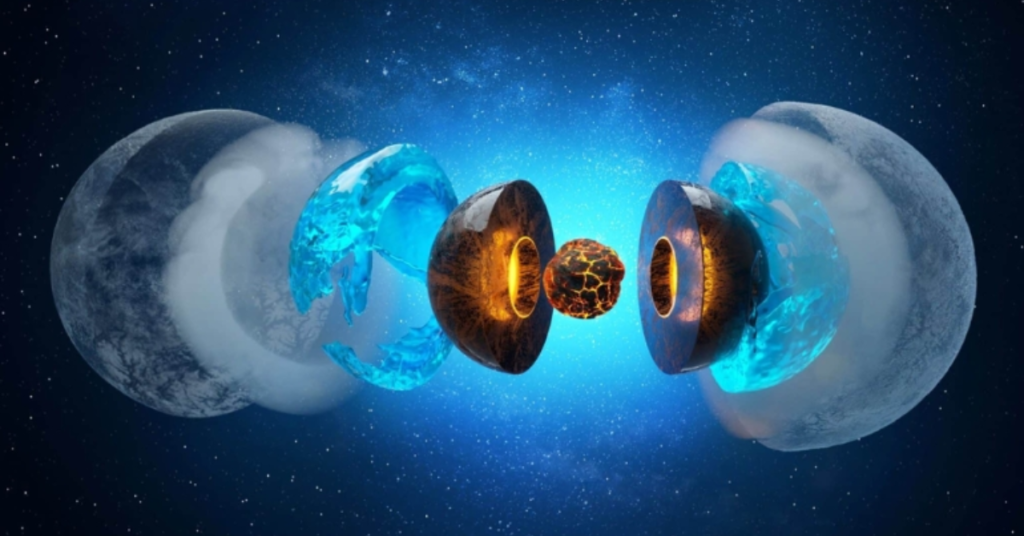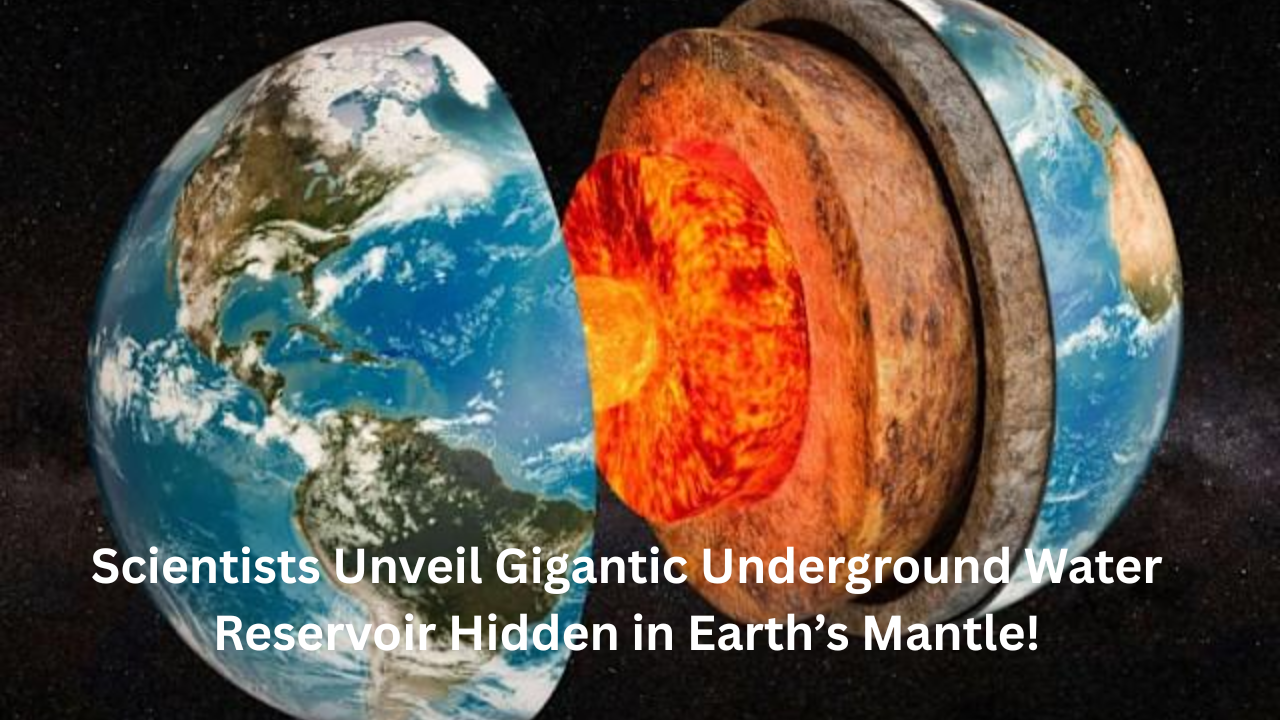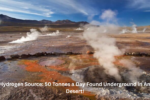Science has brought forth discoveries that seem almost too strange to be true—from the mysteries of black holes to the unveiling of a previously unknown “8th continent.” Even within our planet, new revelations continue to emerge, shedding light on the Earth’s previously untold secrets. One of the most remarkable finds in recent times, however, lies not in outer space or on the Earth’s surface, but deep beneath our feet.
At nearly 400 miles beneath the Earth’s crust, scientists have uncovered a hidden ocean buried in the Earth’s mantle. This subterranean ocean is unlike the ones we’re familiar with; instead, the water is trapped within a mineral called ringwoodite. This discovery is shaking up the scientific community, as it challenges long-held beliefs about how water behaves within our planet.
Unlike the water we know, which exists in liquid, solid, or gaseous form, the water within this hidden ocean exists in what is known as a fourth state—suspended within the rock, much like moisture in a sponge. The breakthrough, revealed in a study titled “Dehydration Melting at the Top of the Lower Mantle,” offers a detailed map of this hidden system, giving researchers their first concrete evidence of such a large water reservoir deep within the Earth’s interior.
The mineral ringwoodite, which contains water, is located in the mantle, an area far below the Earth’s surface, where intense pressure and high temperatures exist. For years, scientists had speculated that water could be trapped within the Earth’s mantle, but this is the first time concrete evidence has been found.
Geophysicist Steve Jacobsen, one of the lead researchers, explains that the mineral ringwoodite is like a sponge, soaking up water and locking it away in a way that few other materials can. The structure of this mineral enables it to absorb hydrogen, trapping water within and storing it deep within the Earth.
But the discovery is not just significant because it challenges the traditional understanding of water on Earth—it also suggests that the planet’s interior could be much wetter than anyone previously imagined. The researchers noted that if only 1% of the ringwoodite contains water, the volume would be three times that of all the oceans on the Earth’s surface.
This realisation is profound because it suggests that the Earth could hold significantly more water than scientists had previously thought. It may also imply that our understanding of the water cycle and its role in the planet’s geology requires a complete reevaluation.
What makes this discovery particularly exciting is the possibility that water plays a key role in the Earth’s internal processes, such as volcanic activity. The water stored in the mantle may influence how the planet’s tectonic plates move, as well as how magma is produced. Water is an essential component in many geological processes, and understanding its distribution and behaviour deep within the Earth will help scientists gain a deeper understanding of the planet’s history and evolution.
Moreover, the discovery of this hidden water raises important questions about the broader implications for the Earth’s water cycle. For years, scientists have assumed that the majority of the Earth’s water resides on the surface, in oceans, rivers, and lakes. While this is true, this hidden ocean suggests that there may be other, much larger reservoirs of water below the surface, waiting to be discovered.
This discovery has captivated not only scientists but also the general public, as it challenges our understanding of the Earth and its functioning. If there are vast bodies of water hiding deep inside the Earth, it opens up many possibilities for future research. How does this hidden water interact with the rest of the planet’s systems? What role does it play in regulating the Earth’s temperature and climate? These are just a few of the many questions that scientists will seek to answer in the years to come.
The Importance of Hidden Water Sources
While this discovery is groundbreaking, it is not the first time that scientists have found hidden sources of water beneath the Earth’s surface. Over the years, researchers have identified several other reservoirs of water deep within the Earth, each contributing to the planet’s water cycle in its unique way.
One of the primary ways water is stored deep within the Earth’s crust is in minerals. Certain minerals, such as olivine, serpentine, and mica, can trap water within their crystal structures. This process, known as mineral hydration, allows water to be chemically bound within the rock, only to be released under specific conditions. For example, when rocks undergo metamorphic transformations, the water that was once trapped inside can be released into the environment, where it can eventually return to the surface.
Another hidden source of water is deep aquifers, which are groundwater reservoirs located thousands of meters below the surface. These aquifers can contain ancient water, some of which has been locked away for millions of years. Accessing these aquifers is challenging due to the extreme depths and high pressures. Still, they represent a significant, untapped source of water that could become more important in the future as surface water sources become increasingly strained.

Subduction zones, where tectonic plates collide and one plate is forced beneath another, also contain hidden reservoirs of water. As oceanic crust is pushed down into the mantle, water from the ocean is carried along with it. Some of this water remains within the crust, bound in minerals or in pore spaces, while other water may return to the surface through volcanic eruptions. This process plays a critical role in the recycling of water within the Earth’s system.
There are also porous rocks within the Earth’s crust that allow water to seep into cracks and cavities. Known as pore water, this water can be found in rocks like sandstone, which have high porosity. When tectonic pressures change or earthquakes occur, this water can be released back into the atmosphere, contributing to the global water cycle.
Another important source of water is water derived from ancient oceans. Rocks formed at the bottom of these ancient oceans often contain trapped seawater or are hydrated, carrying this water with them as they are buried or subducted into the Earth’s crust. As these rocks are transported deeper into the mantle, they retain the water, contributing to the hidden reservoirs beneath the surface.
Finally, fluid inclusions in rocks, which are tiny pockets of water trapped inside minerals during their formation, also contribute to the Earth’s hidden water sources. Though each inclusion contains only a small amount of water, collectively, these tiny bubbles contribute to the total volume of water stored in the Earth’s crust.
These hidden water sources are not only important for understanding the Earth’s geological processes, but they also play a crucial role in the planet’s water cycle. By contributing to volcanic eruptions, earthquakes, and other geological events, they help regulate the movement of water across the Earth’s surface and atmosphere.
The Future of Water Discovery
The discovery of this hidden ocean and other subterranean water sources represents just the tip of the iceberg in understanding the Earth’s water systems. As technology continues to advance and scientists develop new techniques for exploring the Earth’s interior, even more hidden water reservoirs will likely be discovered.
These discoveries will not only deepen our understanding of the Earth but also have practical implications for water resource management. As the global population continues to grow and freshwater resources become increasingly scarce, these hidden water sources could become a vital part of our future water supply.
As we continue to explore the depths of our planet, it’s clear that there is much more to learn about the hidden forces that shape our world. The mysteries of Earth’s interior are only beginning to be unravelled, and each discovery brings us one step closer to understanding the planet we call home.

Deepak Grover is a dedicated content writer at OTE News, specializing in government affairs, public policy, and current events. With a keen eye for detail and a passion for factual reporting, he ensures readers receive accurate and insightful news. Deepak holds a degree in Political Science and has experience in research-driven journalism.
When not writing, he enjoys reading historical books, exploring hiking trails, and staying updated with global political trends. His commitment to ethical journalism makes him a trusted voice at OTE News.










